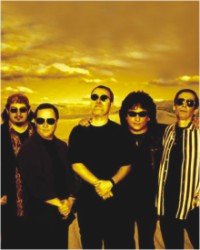| Band Musice
Blue Oyster Cult
Review: Shamma M. Raghib
Band member:
Eric Bloom
Donald Buck Dharma
Allen Lanier
Richie Castellano
Jules Radino  The band got its start in the late '60s on Long Island, New York, as the Soft White Underbelly, but each member had been involved in bands previously in high school and college, before ending up in the “right place at the right time” to create the beginnings of Blue Öyster Cult. The roots of that strange, outlaw motorcycle band, Blue Öyster Cult, can be traced back to the smoky wisps of Psychedelia, when they were known as Soft White Underbelly, Oaxaca, and eventually The Stalk Forest Group. The band got its start in the late '60s on Long Island, New York, as the Soft White Underbelly, but each member had been involved in bands previously in high school and college, before ending up in the “right place at the right time” to create the beginnings of Blue Öyster Cult. The roots of that strange, outlaw motorcycle band, Blue Öyster Cult, can be traced back to the smoky wisps of Psychedelia, when they were known as Soft White Underbelly, Oaxaca, and eventually The Stalk Forest Group.
The brainchild of rock journalist Sandy Perlman, they were signed to Elektra, a deal that only yielded one single. Shortly afterwards, The Stalk Forest Group's lead singer, Les Bronstein, was replaced by Eric Bloom. He completed a line-up, which also consisted of Donald 'Buck Dharma' Roeser, Allen Lanier, Joe Bouchard and Albert Bouchard. Taking their new name from a Perlman lyric, Blue Öyster Cult began to earn a reputation as a fiercely exciting rock band, propelled by Roeser's raw chord dynamics, Perlman's sinister lyrics, and an apocalyptic stage presence based on Hell's Angels imagery and the black and white symbol of Kronos (Saturn), later their trademark.
Perlman molded the sound and image of the band to evoke the spirit of Altamont. The first time album, Blue Öyster Cult (1972) remains a landmark of early 70s rock. The opening chords of Transmaniacon M.C. captured the essence of the band - tight, loud, inventive heavy metal. On the other hand, “She's As Beautiful As A Foot”, with its floating guitar solo, harked back to dreamy, off-centre Psychedelia, illustrating the band's firm grasp of rock's lighter shadings. The follow-up - Tyranny And Mutation (1973) - was just as good, mining the same rich veins of emotional bleakness and driving hedonism on tracks such as O.D.'d On Life Itself. Although the band refuted allegations of neo-Nazism, their third album, 1974's Secret Treaties, seemed to readily embrace a certain cruelty of feeling. However, the lyrics of songs such as Flaming Telepaths and Astronomy were too densely cryptic to have any simple political significance. The stand-out track was Career Of Evil, written by Patti Smith (who was Lanier's girlfriend at the time), and the album outsold their previous efforts in the US. As the hard rock scene lurched between endless twelve-bar boogie re-workings and sludge heavy rifferama, Blue Oyster Cult's early albums had uncommon discipline, and a clear production that was founded on fluidity and restraint.
Concert shows, in contrast, were more excessive, and burgeoning over-soloing characterized the group's first live album, On Your Feet Or On Your Knees (1975). Walking the thin line between genuine force and empty bombast, the Blue Öyster Cult faltered for the first time, although sales remained high. The leather-clad, S&M shock of the band was gradually starting to fade, and a subtle shift towards radio-friendly, melodic hard rock was reflected in their next, and most successful, album, Agents Of Fortune (1976). Diluting their darker energies, it offered instead a varied selection of tuneful material (True Confessions), amidst suitably malignant biker anthems (This Ain't The Summer Of Love).
Don't Fear The Reaper, with its Byrds-like harmonics, offset by dark lyrics, provided the band's defining moment, never to be repeated. This time with two tracks co-written by Patti Smith, the album belatedly broke the band in the UK charts.
By the end of the 70s, however, the band had begun a slow limp towards self-parody, sadly evidenced by Spectres (1978). If early albums traded on enigma, then “R.U. Ready To Rock?” was as dumb and obvious as its title suggests. Subsequent albums, despite the occasional stand-out track - such as Death Valley Nights from Spectres, or Joan Crawford from Fire Of Unknown Origin (1981), seemed content to pander to the feeble SF and demented biker obsessions of their fan base.
Unfortunately, Blue Oyster Cults ended their fame around 1988. Whatever the case, it will remain one of the key bands of the 70's
Tracks to listen to: Don't fear the reaper, Cold Gray Light
Copyright
(R) thedailystar.net 2007 |
